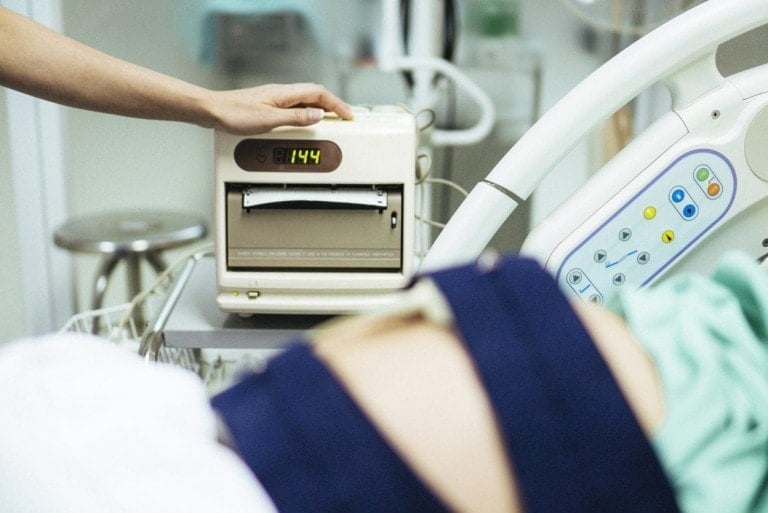Oh, my goodness; you feel huge. You may have had a baby before, but you feel like your baby is measuring big this time. Or your doctor or midwife tells you they think your baby is big or has fetal macrosomia. But what does that mean? Is it dangerous? Can you have a vaginal delivery? Before you get too scared, let me assure you that many women give birth to babies with macrosomia without complications. Keep reading, and we will look at everything to consider. Now, take a big slow breath, and let’s go.
What is Macrosomia?
Macrosomia means “big body.” Fetal macrosomia is when an unborn baby is estimated to be bigger than average. It isn’t just when the baby is due, but at any time during pregnancy. At term, 37 weeks or more, fetal macrosomia is defined as an estimated weight of 4,500 grams or 9 pounds, 15 ounces. Sometimes, 4,000 grams, or 8 pounds, 13 ounces, describe macrosomia.1
Large for gestational age (LGA) is another term you may hear. LGA means your baby’s birth weight is above the 90th percentile for his gestational age. In other words, your baby measures larger than 9 in 10 babies born during the same week of pregnancy.2
In the United States, 7% of babies have a birth weight of over 4,000 grams, and only 1% have a birth weight of over 4,500 grams. Fetal macrosomia is associated with the following:2
Higher chance of complications for the mother, including:
- Excessive bleeding after giving birth.
- Longer pushing stage in labor.
- Increased risk of tears and trauma to your perineum (area between the vagina and anus).
- Increased risk of needing forceps or a vacuum to deliver your baby.
- Higher risk for a C-section delivery.3
Higher chance of complications for your baby, including:
- Shoulder dystocia. This refers to your baby’s shoulders getting stuck during delivery. There is a 5-10% chance of this when your baby has macrosomia.
- Birth injuries, including broken clavicles, bleeding in the brain, and nerve damage.3
- Fetal distress.
- Congenital anomalies most often with diabetic mothers.
- Jaundice
- Low blood sugar.
What Causes Macrosomia?
Babies can become large for reasons associated with the mother or the baby. Let’s look at both.
Causes of macrosomia from the mother:2,3
- Diabetes in pregnancy is a common cause of macrosomia. It can lead to abnormal growth in the baby due to a mother’s elevated blood sugar.
- Obesity is a significant risk factor for diabetes but also for fetal macrosomia.
- Having previous babies is a small risk factor. You have a higher risk if you have had three or more babies before, as each baby tends to get bigger.
- A previous large baby puts you at a higher risk of having another.
- Gaining too much weight during pregnancy.
- Overdue pregnancies past 42 weeks increase your risk of macrosomia.
- Being older than 35 increases your risk.
- Hispanic women are more likely to have large babies.
- Genetics – some women have big babies!
Causes of macrosomia from the baby:
- Fetal gender makes a slight difference. Macrosomia is more common if you are having a boy.
- Certain genetic disorders can cause macrosomia.
The most common causes of fetal macrosomia are maternal diabetes, obesity before pregnancy, excessive weight gain during pregnancy, and having a large baby before.
How is Macrosomia Diagnosed?
Healthcare providers diagnose macrosomia by ultrasound and physical exam, which are inaccurate. Research indicates that ultrasound measurements are as accurate as an experienced doctor or midwife feeling your abdomen. Most ultrasounds are valid within 15% of your baby’s size. That’s a lot of room for error! Remember, fetal weight is only an estimate.2,4,5
As a nurse midwife, I have seen thousands of ultrasound reports. Every report will say “plus or minus 500 grams” or something similar. It is harder to estimate fetal weight in women who are obese, or when there is a large amount of amniotic fluid, the baby is over 4,000 grams, or the woman has diabetes before pregnancy.6
You Might Give Birth to a Big Baby
Since ultrasounds are not always accurate in determining whether you have a baby measuring big, here are several other clues:3
Large Fundal Height
Your provider will measure the size of your uterus in centimeters with a tape measure at every visit in the second half of pregnancy. She will measure from your pubic bone to the top of the uterus. This measurement is called the fundal height. Usually, your fundal height will equal the number of weeks you are pregnant. For example, if you are 38 weeks pregnant, your fundal height will be about 38 cm. A normal range is 2 cm more or less than the number of weeks you are pregnant. So, if your fundal height is more than 2 cm ahead of your weeks, it could be a sign of fetal macrosomia.7
Excessive Amniotic Fluid
Too much fluid around your baby is called polyhydramnios. Polyhydramnios can indicate that your baby has macrosomia. Your baby makes most of the amniotic fluid from her urine. Bigger babies make more urine.7
You Think Your Baby is Big!
A mother who has given birth to at least one baby before may better estimate her baby’s size than an ultrasound or experienced provider. How wise are mothers?8
What Moms Need to Keep in Mind When Baby Measures Big
If you have a baby with suspected macrosomia, there are often changes to your care. Your provider may recommend a Cesarean birth if your baby’s estimated weight is 5,000 grams (11 pounds ) and you do not have diabetes. If you have diabetes, your provider may offer a Cesarean birth if your baby’s estimated weight is 4,500 grams (9 pounds, 15 ounces) or more.4
Early induction of labor is not recommended for fetal macrosomia. Induction at least doubles the chance of cesarean delivery or other risks to the mother. It also does not decrease risks to your baby.2
Your delivering doctor or midwife will be more cautious in offering a vacuum or forceps to help with your delivery if pushing takes a long time. Using a vacuum or forceps with a large baby increases the risk of the shoulders getting stuck, nerve damage, and bleeding in your baby’s brain. The risk is lower if your baby is born through your pushing efforts.9
What You Can Do
Reading about all the scary things that can happen because of fetal macrosomia can cause much anxiety. If you are early in your pregnancy, there are things you can do to decrease your chances of having a baby measuring big. Some things you can do include:
- Gain the recommended amount of weight. The recommended weight gain depends on your starting weight and BMI (body mass index). You can manage your weight gain with a healthy diet and regular exercise.
- If you are a diabetic or become a diabetic during pregnancy (gestational diabetes), do your best to control your blood sugar through diet, exercise, and medications. The assistance of a dietician is often beneficial.
How to Remain Calm
Mothers are very capable of making informed decisions for themselves and their babies. It is vital to have an honest discussion with your doctor or midwife about all the information regarding the size of your baby. Discuss your history and risk factors. Then, evaluate the possible risks and benefits to you and your baby as you plan for delivery. Ultimately, your provider will make recommendations, but the final decision is yours.
As a nurse midwife, I have delivered 11-pound babies without complications. I have also had complicated deliveries of 7-pound babies. There is far more than the fetal weight that impacts delivery. Other factors that determine if your baby will fit are the size and shape of your pelvis and your baby’s position. Women are so strong, and our bodies can do amazing things. Trust in your body and in your ability to make good choices.
Whatever delivery method you choose or attempt, you can make the best decision for yourself and your baby that’s measuring big. No choice is risk-free. The goal is a healthy mother and a healthy baby. So, try remaining calm and know you are doing your best.
Fetal macrosomia is when your baby is estimated to be larger than average. There is no accurate way to determine how big your baby is before he is born. Some risk factors of having a large baby can be addressed, such as weight gain and managing diabetes. It can be hard to decide the safest way to give birth to your baby when she is estimated to have macrosomia. Making hard decisions is part of parenting, starting before your baby’s birth. The final decision is yours, but discussing your options with your healthcare provider is essential.































